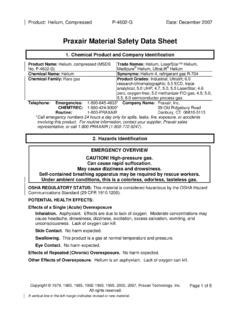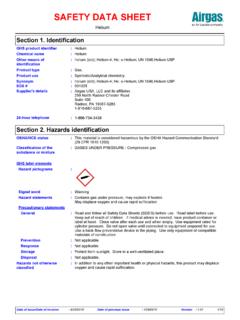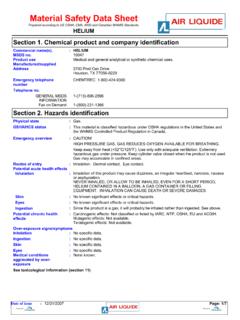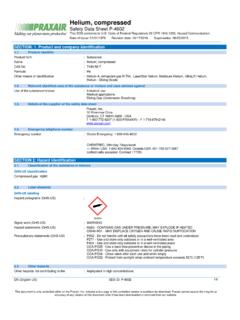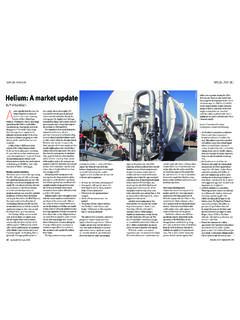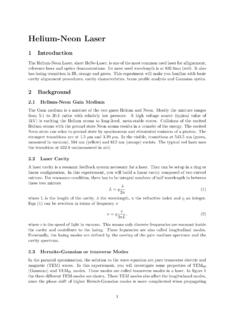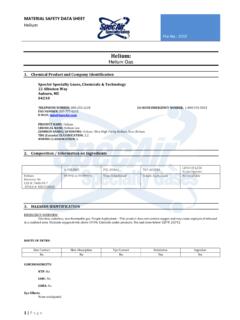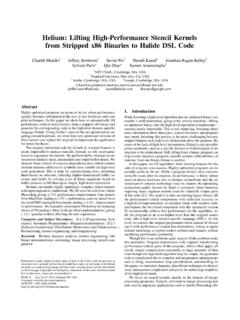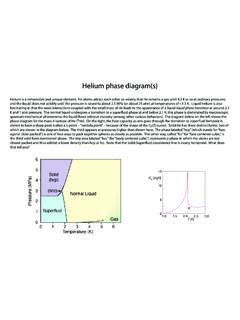Transcription of SAFETY DATA SHEET SDS Number: 061A HELIUM
1 SAFETY data SHEET SDS number : 061a helium Air Products South Africa (Pty) Ltd 1/4 HELIUM / Rev 2 / 2016-03 1. PRODUCT AND COMPANY IDENTIFICATION Product Name : HELIUM Chemical formula : He Synonyms : HELIUM , HELIUM gas, Gaseous HELIUM , Balloon Gas Use of the substance/preparation : General Industrial Manufacturer/Importer/Distributor : Air Products South Africa (Pty) Ltd. Silver Stream Business Park, 1st Floor, Building 3, 10 Muswell Road South, Bryanston, 2191 Telephone : +27 (0)11 570 5000 (Head Office) +27 (0)11 977 6444 (Customer Care Cylinders) 0800 023 298 (Engineering / Bulk Services) Emergency telephone number (24h) : 0800 650 315 2.
2 COMPOSITION / INFORMATION ON INGREDIENTS Components CAS number Concentration (Volume) HELIUM 7440-59-7 100 % Concentration is nominal. For the exact product composition, please refer to Air Products technical specifications. 3. HAZARDS IDENTIFICATION Main Hazard / Emergency Overview High pressure gas. Simple asphyxiant - Can cause rapid suffocation. Self contained breathing apparatus (SCBA) may be required. Potential Health Effects Inhalation : In high concentrations may cause asphyxiation. Asphyxiation may bring about unconsciousness without warning and so rapidly that victim may be unable to protect themselves.
3 Eye contact : No adverse effect. Skin contact : No adverse effect. Ingestion : Ingestion is not considered a potential route of exposure. Chronic Health Hazard : Not applicable. Aggravated Medical : None. Condition Symptoms : Exposure to oxygen deficient atmosphere may cause the following symptoms: Dizziness. Salivation. Nausea. Vomiting. Loss of mobility/consciousness. Environmental Effects Not harmful. 4. FIRST AID MEASURES General advice : Remove victim to uncontaminated area wearing self contained breathing apparatus.
4 Keep victim warm and rested. Call a doctor. Apply artificial respiration if breathing stopped. Eye contact : Not applicable. Skin contact : Not applicable. Ingestion : Ingestion is not considered a potential route of exposure. Inhalation : Remove to fresh air. If breathing has stopped or is labored, give assisted respirations. Supplemental oxygen may be indicated. If the heart has stopped, trained personnel should begin cardiopulmonary resuscitation immediately. In case of shortness of breath, give oxygen. SAFETY data SHEET HELIUM SDS number : 061A Air Products South Africa (Pty) Ltd 2/4 HELIUM / Rev 2 / 2016-03 5.
5 FIRE-FIGHTING MEASURES Suitable extinguishing media : All known extinguishing media can be used. Specific hazards : Upon exposure to intense heat or flame, cylinder will vent rapidly and or rupture violently. Product is nonflammable and does not support combustion. Move away from container and cool with water from a protected position. Keep containers and surroundings cool with water spray. Special protective equipment : Wear self contained breathing apparatus for fire fighting if for fire-fighters necessary. 6. ACCIDENTAL RELEASE MEASURES Personal precautions : Evacuate personnel to safe areas.
6 Wear self-contained breathing apparatus when entering area unless atmosphere is proved to be safe. Monitor oxygen level. Ventilate the area. Environmental precautions : Do not discharge into any place where its accumulation could be dangerous. Prevent further leakage or spillage if safe to do so. Methods for cleaning up : Ventilate the area. Additional advice : If possible, stop flow of product. Increase ventilation to the release area and monitor oxygen level. If leak is from cylinder or cylinder valve, call the Air Products emergency telephone number .
7 If the leak is in the user's system, close the cylinder valve, safely vent the pressure, and purge with an inert gas before attempting repairs. 7. HANDLING AND STORAGE Handling Protect cylinders from physical damage; do not drag, roll, slide or drop. Do not allow storage area temperature to exceed 50 C. Only experienced and properly instructed persons should handle compressed gases. Before using the product, determine its identity by reading the label. Know and understand the properties and hazards of the product before use.
8 When doubt exists as to the correct handling procedure for a particular gas, contact the supplier. Do not remove or deface labels provided by the supplier for the identification of the cylinder contents. When moving cylinders, even for short distances, use a cart (trolley, hand truck, etc.) designed to transport cylinders. Do not remove valve guards. Before connecting the container, check the complete gas system for suitability, particularly for pressure rating and materials. Before connecting the container for use, ensure that back feed from the system into the container is prevented.
9 Ensure the complete gas system is compatible for pressure rating and materials of construction. Ensure the complete gas system has been checked for leaks before use. Employ suitable pressure regulating devices on all containers when the gas is being emitted to systems with lower pressure rating than that of the container. Open valve slowly. If user experiences any difficulty operating cylinder valve discontinue use and contact supplier. Close container valve after each use and when empty, even if still connected to equipment.
10 Never attempt to repair or modify container valves or SAFETY relief devices. Damaged valves should be reported immediately to the supplier. Close valve after each use and when empty. Do not subject containers to abnormal mechanical shocks which may cause damage to their valve or SAFETY devices. Never attempt to lift a cylinder by its valve guard. Do not use containers as rollers or supports or for any other purpose than to contain the gas as supplied. Never strike an arc on a compressed gas cylinder or make a cylinder a part of an electrical circuit.



